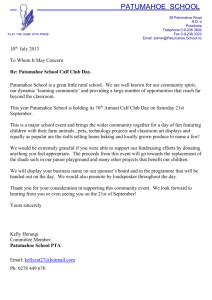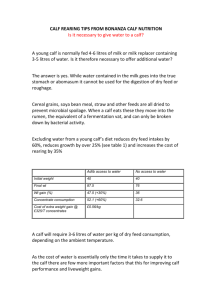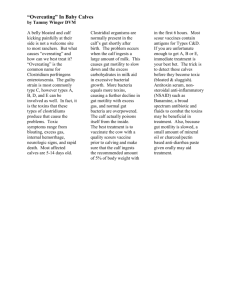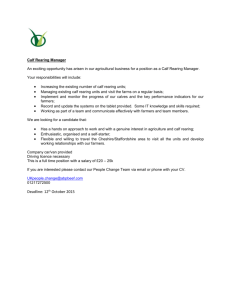Bucket/Bottle Calf Class
advertisement
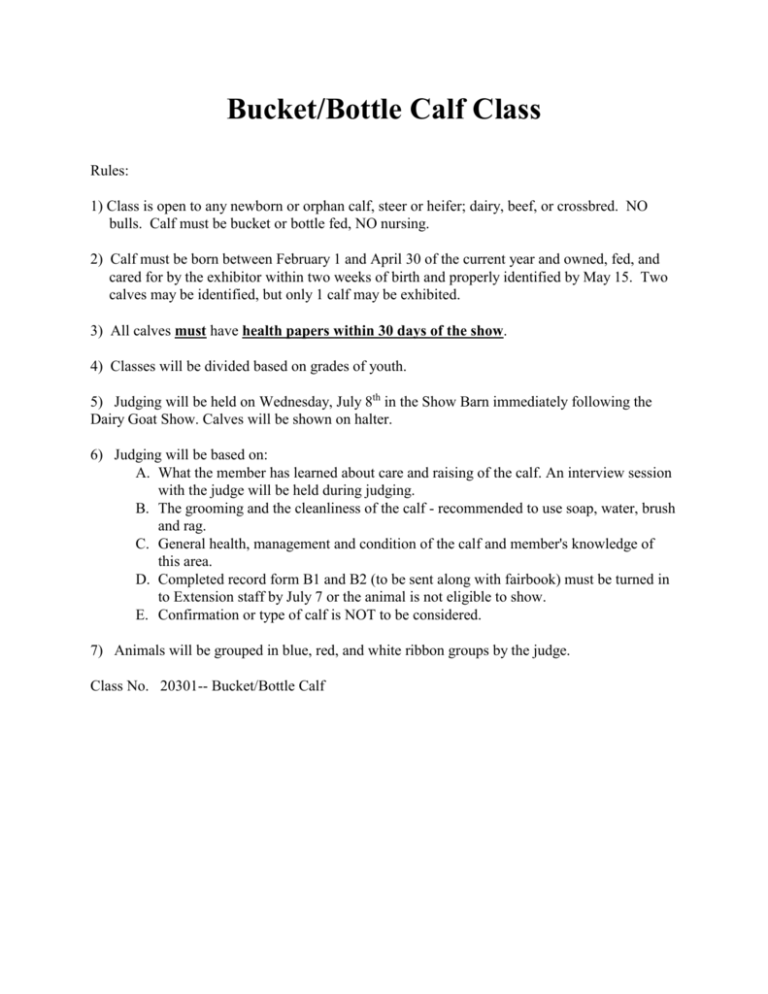
Bucket/Bottle Calf Class Rules: 1) Class is open to any newborn or orphan calf, steer or heifer; dairy, beef, or crossbred. NO bulls. Calf must be bucket or bottle fed, NO nursing. 2) Calf must be born between February 1 and April 30 of the current year and owned, fed, and cared for by the exhibitor within two weeks of birth and properly identified by May 15. Two calves may be identified, but only 1 calf may be exhibited. 3) All calves must have health papers within 30 days of the show. 4) Classes will be divided based on grades of youth. 5) Judging will be held on Wednesday, July 8th in the Show Barn immediately following the Dairy Goat Show. Calves will be shown on halter. 6) Judging will be based on: A. What the member has learned about care and raising of the calf. An interview session with the judge will be held during judging. B. The grooming and the cleanliness of the calf - recommended to use soap, water, brush and rag. C. General health, management and condition of the calf and member's knowledge of this area. D. Completed record form B1 and B2 (to be sent along with fairbook) must be turned in to Extension staff by July 7 or the animal is not eligible to show. E. Confirmation or type of calf is NOT to be considered. 7) Animals will be grouped in blue, red, and white ribbon groups by the judge. Class No. 20301-- Bucket/Bottle Calf Your Bucket/Bottle Calf Project CONTENTS Page Introduction Purpose Project Guidelines County Fair Guidelines End of Project Report 1 1 1 1 Management Outline Colostrum Milk Replacer Calf Starter Housing Health 2 2 2 3 3 Beef & Dairy Terms Talk Like a Beef & Dairy Producer 4 Blue Prints Pen Door Blueprint Pen Blueprint 5 6 **************************************************************************************** PREPARED BY: Paul Brown, Ag Farm Management Specialist - Chickasaw County Linda Engelken-Fisher, Benton County Extension Education Director Scott Ermer, Youth & 4-H - Linn County REVISED & EDITED BY: Dan Burkhart, Fayette County Extension Education Director Judy Mohlis, Fayette County Office Assistant INTRODUCTION INTRODUCTION COUNTY FAIR GUIDELINES The Bucket/Bottle Calf project is offered to all junior 4-H'ers. Anyone interested in this project must be enrolled in the Bucket/Bottle Calf project. Contact the Extension Office for enrollment details. * All calves must have health papers. PURPOSE In the Bucket/Bottle Calf project you can learn: * Proper health care and nutritional requirements of young cattle. * Basic beef and dairy management skills without a large investment. * Calves should not be clipped or fitted. * See fairbook General Livestock Rules for suggested showing attire. * Calves will be shown at halter. The classes will be divided according to age of the exhibitor. * Judging will be based on: a) What the member has learned about care and raising of the calf. An interview session with the judge will be held during the judging. * Basic record keeping skills. * Gain a better understanding of the feeder cattle and replacement animal industry. PROJECT GUIDELINES * Any junior 4-H member may exhibit in this class. * Member must be enrolled in the Bucket/Bottle Calf project by May 1. b) The grooming and cleanliness of the calf. Recommended to use soap, water, brush, and rag. c) General health, management and condition of the calf and the 4-H member’s knowledge of this area. d) Confirmation or quality of the calf is NOT to be considered. e) Completed record forms B-1 and B-2 must be turned in to the Extension office by July 7th. * Calf must be born between February 1 and April 30 and purchased within 2 weeks of birth. Must be in possession of exhibitor by May 15. END OF PROJECT REPORT * Open to any newborn or orphan calf, steer or heifer; dairy, beef, or crossbred. * Calf must be bucket or bottle fed, NO nursing. * Calves must be identified on the Bucket/Bottle Calf Identification form by May 15. * Up to 2 animals may be identified, but a limit of one calf exhibited. * Refer to your fairbook for specific class details. By July 7th you will be required to submit a report on your project. This report needs to contain forms B-1 and B-2. Add any other material that you would like to this record. Please include a picture of yourself with the calf with this report. Complete forms B-1 and B-2, as the year progresses, don’t wait until the end. Above all, have fun with this project, it is a great learning experience. MANAGEMENT OUTLINE COLOSTRUM * When first born, calves lack antibodies and certain nutrients. * Newborn calves acquire both immunity against many diseases plus certain vitamins from cows first milk, which is called colostrum. * Try to give the calf some colostrum within 15 to 30 minutes after birth and a full feeding within 12 hours of birth. Follow these consumption guidelines: 120 lb. calf needs 6 lbs. within 12 hours 100 lb. calf needs 5 lbs. within 12 hours 60 lb. calf needs 3 lbs. within 12 hours * The calf is usually removed from the cow 18-24 hours after birth and is bottle fed colostrum for 3-4 days. * Before purchasing a calf, ask the seller if the calf did receive colostrum for the first 3-4 days after birth. * Veterinarians can perform a blood test called Zinc Sulfate Tribidity - to determine whether or not the calf did indeed receive colostrum. * Start milk replacer on the fourth day after birth. * Calves should be fed twice daily at 8% body weight. * Follow directions on milk replacer bag. * Calves should be on milk for at least 4-5 weeks. * Feed fresh milk at each feeding. a) Milk should be fed at 100o F. CALF STARTER * Begin feeding a calf starter at about 7-10 days of age plus a handful of high quality hay. * Change feed and hay often to prevent it from becoming stale. * Try to encourage the calf to eat some starter after it is finished with it’s milk. * Allow calves to have access to a little fresh water during the day when they begin consuming feed. * Calves can be weaned at 4-5 weeks when they are consuming 1.5-2 lbs. of starter per day. Do not wean until they have reached this level of consumption. * Feed starter up to four months of age, plus free choice hay. * A calf’s rumen does not develop fully until 5-6 months of age. MILK REPLACER * Purchase a high quality milk replacer. a) The milk replacer MUST contain a milk based protein and NOT a soybean based protein. b) Calves will starve to death on soybean based protein because they cannot easily digest it. MANAGEMENT OUTLINE HOUSING Ventilation and isolation are very important. a) Calves do the best in their own hutch or pen. b) Calves must not be housed near or with other livestock. c) Penning two or more calves together is not a good idea because of possible sucking problems. * Utilize an individual calf hutch out in the open or in a machine shed. * Clean, fresh air is important in preventing health problems. * Bed individual pens deeply with clean straw. HEALTH * Have a veterinarian check the calf shortly after arrival. * Ask your veterinarian about the following: a) A Vitamin A, D, and E injection. b) A Ralgro or Synovex implant for calves not intended for breeding purposes. c) IBR (Infectious Bovine Rhinotracheitis), BVD (Bovine Virus Diarrhea), Clostridial Diseases (Black Leg & Enterotoxemia). d) Conditioning of the calf. e) Fly tags in June. f) Lice control. * Worming is not necessary until after the calves have been on pasture. * Check the calf before each feeding for any health problems. BEEF & DAIRY TERMS TALK LIKE A BEEF & DAIRY PRODUCER To talk like a knowledgeable cattle producer, you may want to learn some of the commonly used words. Studying the following terms will help you. Some of them may sound simple, but you’ll be surprised how many 4-H’ers don’t know the real definitions! Antibiotics -- Medicines given to animals for health purposes to treat problems caused by certain microorganisims. Antibodies -- The immunoglobulins and other blood serum proteins that are found in colostrum. Bull -- Uncastrated male cattle of any age. Calves -- Young cattle of either sex less than one year of age. Calving (Freshening, Parturition) -- The act of giving birth. Calving Difficulty (Dystocia) -- Abnormal or difficult labor causing difficulty in delivering the fetus and placenta. Carcass Merit -- Desirability of a carcass relative to quantity of edible portion and quality of product. Colostrum -- The first milk; high in antibodies; produced by a female mammal after it gives birth. Conception -- The fertilization of the ovum or egg. The act of conceiving or becoming pregnant. Cow -- A female that has had one or more calves. Crossbred -- An animal with pure-bred parents of different breeds, or grade parents. Cull -- To eliminate an animal of low quality from a herd. Cutability -- Carcass cutout value, or yield of saleable meat; sometimes designated as yield grade by USDA meat graders. Dam -- The mother of a calf. Dropped -- Born; given birth to. Dry Period -- When the cow is no longer being milked, by machine or by a calf, prior to freshening. Estrus -- The recurring period of sexual excitement in mature cows; when the cow will accept the bull; heat period. Fetus -- The unborn young of cattle after the body parts are formed. Finish -- The degree of fatness. Founder -- A nutritional ailment from overeating; foundered animals become lame with sore front feet and excessive hoof growth. Freemartin -- The female member of unlike twins in cattle, showing many male characteristics and incapable of reproduction. Half-Sibs -- Individual cattle having the same sire or dam. Half-brothers and half-sisters. Heifer -- A female that has not had a calf. Inbreeding -- Occurs when sire and dam are close relatives. Linebreeding -- Selective breeding, sire and dam with similar heredity, but not as closely related as inbreeding. Marbling -- The percentage of fat distributed throughout the meat. Open -- Refers to the non-pregnant female. Ovulation -- Release of the female germ cell (egg) by the ovary. Cows usually ovulate several hours (up to 15 hours) after the end of estrus or standing heat. Performance Test -- A measure of individual performance; specifically, the rate and efficiency of growth of a steer, and carcass traits. Polled -- Cattle that are born without horns. Registered -- An animal whose name, along with the name and number of it’s sire (father) and dam (mother), has been recorded in the record of it’s breed association. The association gives the animal a number, known as the registration number. The association also issues a registration certificate showing that the animal has been registered. Scurs -- Horny tissue or rudimentary horns that are attached to the skin rather than the bony parts of the head. Sire -- The bull that fathers a calf. Springer -- Heifer or cow showing signs of advanced pregnancy; near to calving. Stag -- Male bovine castrated after sex characteristics are developed. Steers -- Male cattle that were castrated at an early age before sex characteristics developed. WINNESHIEK COUNTY BUCKET/BOTTLE CALF PROJECT (Complete and turn in to the Extension Staff by July 7th) MEMBERS NAME ______________________________________________________________________ CLUB _______________________________________________________________ AGE ____________ CALF’S DATE OF BIRTH _______________ COLOR OF CALF ________________________________ DATE PURCHASED _______________ OR DATE SELECTED ______________ PURCHASE PRICE $__________ OR ESTIMATED VALUE WHEN BORN ON FARM $ _________ BREED OF SIRE _______________ BREED OF DAM _______________ *************************************************************************************** Describe facilities where you housed your calf: Describe the feeding program you followed the first 3-4 days that you got your calf: (type of feeds, amount per day, etc.) Describe the feeding program for the next 3-4 weeks: (kinds, amounts per day, etc.) Describe the feeding and management after you had the calf for a month: B-1 Did your calf have any health problems? (Describe problem and what you did to treat it.) What did you do to prevent health problems? What other management practices have you followed to help your calf to be healthy and to grow? What have you enjoyed and learned through this project? What was the biggest problem you had and what did you do to solve it? Attach a photo of you and your calf to this form. B-1 -- page 2 COST OF RAISING A BUCKET/BOTTLE CALF (Complete and turn in to the Extension office by July 7th) Feed Pounds Cost per Pound Total Pounds Cost per Pound Total Milk Replacement Starter Hay Other Bedding Bedding Medication (Explain) _______________ Veterinary Charges (Explain) ________________ Other Supplies (Explain) ________________ Total Cost ________________ Purchase Cost of Calves (Value of calf at beginning of project) _________________ Total Invested ________________ B-2

